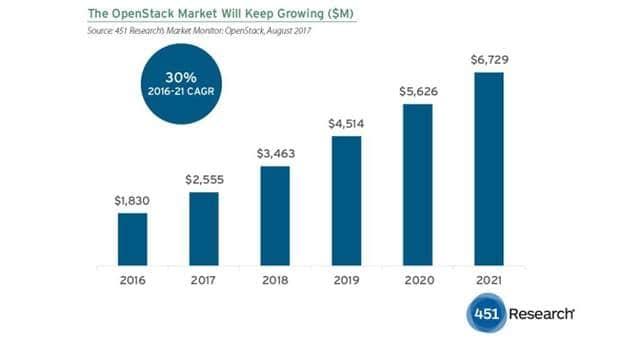451 Research predicts that service providers with OpenStack private cloud revenue will exceed revenue from service providers with OpenStack-based public cloud implementations in 2018, sooner than previously expected.
From a regional perspective, deployments in China and APAC are now growing faster than in the rest of the world. While not the primary driver, a contributing factor is the Chinese government’s Ministry of Industry and Information Technology advocating for OpenStack.
The latest study, published on the first day of OpenStack Summit 2017, forecasts OpenStack revenue will exceed $6bn by 2021, as it experiences a growth rate of 30% CAGR.
OpenStack is benefiting from the increase in hybrid cloud environments with 451 Research’s Voice of the Enterprise: Storage Survey finding that 61% of the enterprises surveyed now utilize a hybrid cloud approach. Certain verticals and regions that are less enthusiastic about exclusively using hyperscalers also present a growth area for OpenStack.
451 Research believes the OpenStack development community has made progress addressing challenges in installation and rolling upgrades over the last two years, resulting in increasing production deployments. This will continue in 2018 as OpenStack becomes more shrink-wrapped and risk is reduced for enterprise use. The platform was once limited to mostly development/testing and proof-of-concept deployments but there are now mission-critical workloads on OpenStack across nearly all enterprise verticals and regions.
To date, OpenStack revenue has been overwhelmingly from service providers offering multi-tenant IaaS, but 451 Research Market Monitor finds that OpenStack growth is now shifting towards the private cloud space faster than previously expected.
While containers are eclipsing OpenStack in terms of attention, 451 Research’s OpenStack Pulse finds that very few OpenStack users are abandoning OpenStack. In reality, some of the most innovative and progressive OpenStack deployments feature the use of container technology such as Docker and Kubernetes.
“OpenStack has solidified its position as the leading open source option for building private and public cloud environments but it is no longer the shiny new toy in the industry – that torch has been passed to containers and microservices. And while there is no clear answer yet about OpenStack coexistence with containers, it is worth noting that containers and container management are nascent markets in terms of production use cases,” said Al Sadowski, Research Vice President at 451 Research.




















